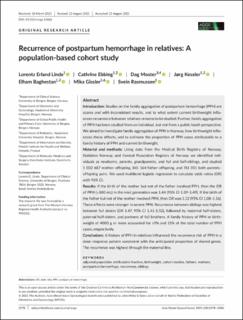| dc.description.abstract | Introduction
Studies on the family aggregation of postpartum hemorrhage (PPH) are scarce and with inconsistent results, and to what extent current birthweight influences recurrence between relatives remains to be studied. Further, family aggregation of PPH has been studied from an individual, but not from a public heath perspective. We aimed to investigate family aggregation of PPH in Norway, how birthweight influences these effects, and to estimate the proportion of PPH cases attributable to a family history of PPH and current birthweight.
Material and methods
Using data from the Medical Birth Registry of Norway, Statistics Norway, and Central Population Registry of Norway we identified individuals as newborns, parents, grandparents, and full and half-siblings, and studied 1 002 687 mother–offspring, 841 164 father–offspring, and 761 011 both-parents–offspring pairs. We used multilevel logistic regression to calculate odds ratios (OR) with 95% CI.
Results
If the birth of the mother but not of the father involved PPH, then the OR of PPH (>500 mL) in the next generation was 1.44 (95% CI 1.39–1.49). If the birth of the father but not of the mother involved PPH, then OR was 1.12 (95% CI 1.08–1.16). These effects were stronger in severe PPH. Recurrence between siblings was highest between full sisters (OR 1.47, 95% CI 1.41–1.52), followed by maternal half-sisters, paternal half-sisters, and partners of full brothers. A family history of PPH or birthweight of 4000 g or more accounted for ≤5% and 15% of the total number of PPH cases, respectively.
Conclusions
A history of PPH in relatives influenced the recurrence risk of PPH in a dose–response pattern consistent with the anticipated proportion of shared genes. The recurrence was highest through the maternal line. | en_US |

